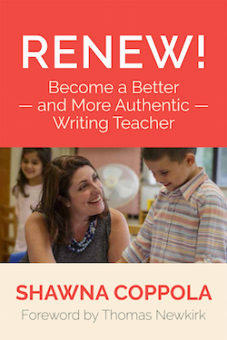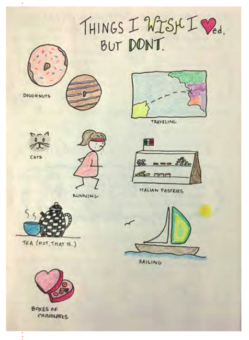Ways to Become a More Authentic Writing Teacher
Renew! Become a Better—and More Authentic—Writing Teacher
By Shawna Coppola
(Stenhouse, 2017 – Learn more)

There are many books on writing and writers’ workshop out there. Coppola distinguishes hers by bringing a breezy, humorous, and feisty voice to the table.
She includes her own tongue-in-cheek doodles as reference diagrams and isn’t afraid to dig into her challenges as a teacher, an instructional coach, a mother, and a writer.

Writers who understand how they make their own writing better are able to share that with their students.
Rethink some long-held assumptions about what writing “looks” like
Coppola challenges us to reconsider three long-standing traditions of classroom writing instruction: a step-by-step writing process, graphic organizers, and the prioritization of words over images.
Instead of bringing students through distinct prewriting/drafting/proofreading stages of their writing, the author invites us to teach student writers how to navigate those steps on their own. She suggests sharing our own processes for writing in our writer’s notebooks and using instructional time for teaching process.
While her focus in this book is on grades k-6, I could easily see how writing process mini-lessons could be adapted for grades 7 and 8. We might teach students how to label their revisions, how to go back into a word processing document or a notebook and add new information, or how to rewrite a scene.
Coppola also pushes for us to rethink the purpose and structure of a graphic organizer. Not every student needs one, and not every student will benefit from the same graphic organizer for the same assignment. In some cases, as she shows through student work, graphic organizers can reduce a heartfelt piece about spending time with a parent into a series of loosely related sentences.
Instead of giving out the same sheet of paper to all students, we should teach and show students several kinds of graphic organizers and allow students to use a way of organizing thoughts that seems helpful to the task.
Integrating drawing and illustration
Third and most unconventionally, Coppola pushes us to see drawing and illustration as an important component to the composition and revision process. Students who like to draw are engaging in ideas and are often telling themselves stories about their ideas. Some students will be inspired to write through their visualizations and their images.
This concept is an easier sell for lower elementary school, where students are given space to draw as they write, but it’s less conventional in middle school classrooms. The author uses examples from her own notebook and examples from author-illustrators to show how drawing is a vital component of the writing process, for adults as well as young children.
Coppola’s book stuck with me, and I was able to use some of her advice in the classroom right away. For example, I started using my own writer’s notebook more often when I conferred with students if I wanted to demonstrate a technique or show them a strategy. I also helped students generate graphic organizers that were unique to their purposes and challenges as writers.
One student writer knew how he wanted to end his story but he wasn’t sure how to get there, so I showed him a graphic organizer where I jotted a note on the ending and we worked backwards. Another student author was torn on writing about contradictory events, so I demonstrated a literal “story map” where I doodled out the locations of his story and jotted down the major events in each location.
This is a stocking stuffer, not a textbook
Coming in at 120 pages and plenty of diagrams, there’s a lot of the nitty gritty of implementation that this book leaves out. That’s okay, but it means that it can be difficult to implement some of these ideas when I return to my classroom soon. Reading about new ideas is not always the same as using them in the classroom, and the more information a book gives me about introducing a strategy, the more likely I am to use it in the classroom.
Read Shawna Coppola’s MiddleWeb article:
“Rethink First-Day Writing to Better Engage Kids.”
I would have also liked to have seen more teacher anecdotes or examples of student writing after some of these strategies were implemented. For example, I would have enjoyed seeing how a student’s piece flourished after she saw another graphic organizer option or how a student’s sketches informed a finished piece. I wonder how students saw themselves grow as writers once their teachers started to renew their assumptions and practices.
Amy Estersohn is a middle school English teacher who blogs at Three Teachers Talk. She is a 2016 recipient of the Gallo Grant from the NCTE’s Assembly on Literature for Adolescents and can be found on Twitter at @HMX_MSE.



































Thank you for your thoughtful review, Amy. You make some excellent points that I will definitely keep in mind for future writing projects!